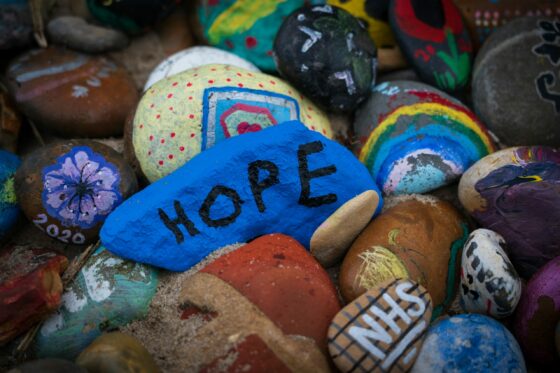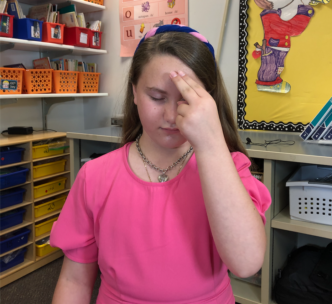 In my fifth grade classroom during the peak COVID era—a hugless year of masks, social distancing and hand sanitizer, I had a student named Chloe (watch her video here) who ended every one of her imagine stories with the same two words, “Imagine Hope!” At the time I found those words catchy and inspiring–and so did my class. In fact, eventually everyone ended their Imagine stories with “Imagine Hope!”, and it became our class motto. Quite fitting for that specific year.
In my fifth grade classroom during the peak COVID era—a hugless year of masks, social distancing and hand sanitizer, I had a student named Chloe (watch her video here) who ended every one of her imagine stories with the same two words, “Imagine Hope!” At the time I found those words catchy and inspiring–and so did my class. In fact, eventually everyone ended their Imagine stories with “Imagine Hope!”, and it became our class motto. Quite fitting for that specific year.
Why is hope important:
Hope is a word that gets used a lot but may not be understood as well as it needs to be.
I love this quote from Brene’ Brown’s book, The Gifts of Imperfection: Let Go of Who You Think You’re Supposed to Be and Embrace Who You Are (I also really love this entire book)!
“Hope is not an emotion; it’s a way of thinking or a cognitive process. Emotions play a supporting role, but hope is really a thought process made up of… a trilogy of goals, pathways, and agency. In very simple terms, hope happens when…
We have the ability to set realistic goals (I know where I want to go).
We are able to figure out how to achieve those goals, including the ability to stay flexible and develop alternative routes (I know how to get there, I’m persistent, and I can tolerate disappointment and try again).
We believe in ourselves (I can do this!).”
This explains why Chloe’s intuitive “Imagine Hope!” was so inspirational to my students. Hope leads to action. In The Imagine Project writing process, the writer is asked to write about a difficult time in life to help with emotional expression and processing—using the word Imagine to begin every sentence. Then in step 4, the writer is asked to write how they would like their story to end (also using the word Imagine), encouraging the writer to take a hopeful turn.
To better understand what hope is, let’s first understand what hope isn’t:
Hope isn’t positive thinking. Too often positive thinking is used to avoid the uncomfortable emotions in life and can be wielded like a weapon by people who just want to avoid discomfort. Comments like, “Look on the bright side!” or “Just think positive!” can lead to the suppression of genuine emotions that need to be expressed. The Imagine Project leads with acknowledging the discomfort of life so that people can feel, see, and hear right where they are. Instead of only positive thinking, the writer is asked to imagine their story taking a hopeful turn, it invites the writer and the listener to imagine a different future for themselves, and then to take steps forward to move toward that hopeful future while accepting the difficult present.
Psychologist Dr. Andrea Bonoir wrote about the health benefits of hope in an article for Psychology Today, In it she writes “We feel less helpless and less uncertain about the future (and helplessness and uncertainty both increase our stress, in ways that can be detrimental to our health over time). Increased hope also gives us a buffer in order to sustain some setbacks: it can help with our resilience when there are bumps in the road, helping us have the energy to continue on the path that we are on before giving up.”
In addition, Laura King, a researcher from the University of Missouri Department of Psychological Sciences, did a study on the health benefits of writing about life goals, and she discovered that, “Five months after writing, a significant interaction emerged such that writing about trauma, one’s best possible self, or both were associated with decreased illness compared with controls. Examining the most hopeful aspects of our lives through writing—our best imagined futures, our “most cherished self-wishes” (Allport, 1961)—might also bestow on us the benefits of writing that have been long assumed to be tied only to our traumatic histories.”
We encourage you to write your imagine story (click here for the free journal), when you get to the end of your imagine story, try framing the ending around a “hopeful turn.” Sometimes people really struggle coming up with ideas for a hopeful ending to their imagine stories, especially students. To assist with this, we have been given generous permission by Bret Stein, the creator of The Feelings Wheel (download it here). It is an integral part of the Center for Nonviolent Communication and now we are using it to help people identify feelings that can help drive their imagine stories.
Here is how it works:
The wheel is divided into twelve core emotions, six of which we feel when our needs are not being met, and six of which we feel when our needs are being met. The feelings are organized by color with opposites directly across from each other. After writing your imagine story focused on the feelings you have when your needs are not being met, find the “hopeful turn” by identifying the opposite emotion you hope to feel directly across the wheel and then write what you imagine happening to experience that feeling.
It is my hope that you and your students will experience the power of The Imagine Project and the “hopeful turn” and that it will lead to goal setting, resiliency, and agency. Download the free journals here to get started!
Imagine Hope!
Written by Todd Daubert, Educational Consultant, The Imagine Project, Inc.

 Most adults and children feel anxiety at some point in their lives. Unfortunately, the incidence of anxiety has increased over the last decade, and dramatically increased since the pandemic began. Anxiety is evoked by a change in life’s normal patterns or new unexpected events, challenging experiences, watching social media, even pressure from work, school, parents, friends, and family. Children may feel more anxiety because of changes in classrooms, life’s developmental challenges, feeling left out, too much pressure from family or school, and/or confusion about how life is supposed to work as they watch social media and new experiences of life unfold around them.
Most adults and children feel anxiety at some point in their lives. Unfortunately, the incidence of anxiety has increased over the last decade, and dramatically increased since the pandemic began. Anxiety is evoked by a change in life’s normal patterns or new unexpected events, challenging experiences, watching social media, even pressure from work, school, parents, friends, and family. Children may feel more anxiety because of changes in classrooms, life’s developmental challenges, feeling left out, too much pressure from family or school, and/or confusion about how life is supposed to work as they watch social media and new experiences of life unfold around them. Many people are curious about Emotional Freedom Technique (EFT), also called Tapping. Tapping is a tool anyone can use to help them deal with difficult emotions in life. All ages can be taught to use tapping, as young as 6 or 7 years old or as old as 100! It’s a simple, yet effective technique that can calm your nerves, relief anxiety, help you move through difficult emotions, and even help relieve physical pain and other ailments.
Many people are curious about Emotional Freedom Technique (EFT), also called Tapping. Tapping is a tool anyone can use to help them deal with difficult emotions in life. All ages can be taught to use tapping, as young as 6 or 7 years old or as old as 100! It’s a simple, yet effective technique that can calm your nerves, relief anxiety, help you move through difficult emotions, and even help relieve physical pain and other ailments. The Imagine Project became a nonprofit a little over 5 years ago. We have grown tremendously in those 5 years, currently reaching over a quarter of a million kids! The journey of starting a nonprofit is always a challenging one with many obstacles and lessons, and we have survived and thrived! The lessons of business are expected, but the powerful lessons of life that the thousands of stories we’ve heard that go far beyond what we had expected. I’d love to share what we’ve learned.
The Imagine Project became a nonprofit a little over 5 years ago. We have grown tremendously in those 5 years, currently reaching over a quarter of a million kids! The journey of starting a nonprofit is always a challenging one with many obstacles and lessons, and we have survived and thrived! The lessons of business are expected, but the powerful lessons of life that the thousands of stories we’ve heard that go far beyond what we had expected. I’d love to share what we’ve learned. Transitioning to a Trauma Informed School has become an important movement across the United States, particularly in those schools with a high population of at-risk students. Schools in poorer communities, communities with high crime, even rural areas are seeing the positive effects of applying Trauma Informed principles into their overall curriculum. Even if your school does not have a high-risk student population, it’s important to understand that trauma is in all schools. Yes, it may be higher in certain communities, but as many know, the ACES research showed that 50% of all kids in white, middle class, well-educated communities have at least one traumatic experience before the age of 17. This means every school has students who’ve experienced trauma. Becoming a Trauma Informed School is of utmost importance in helping all children succeed in school, and in life.
Transitioning to a Trauma Informed School has become an important movement across the United States, particularly in those schools with a high population of at-risk students. Schools in poorer communities, communities with high crime, even rural areas are seeing the positive effects of applying Trauma Informed principles into their overall curriculum. Even if your school does not have a high-risk student population, it’s important to understand that trauma is in all schools. Yes, it may be higher in certain communities, but as many know, the ACES research showed that 50% of all kids in white, middle class, well-educated communities have at least one traumatic experience before the age of 17. This means every school has students who’ve experienced trauma. Becoming a Trauma Informed School is of utmost importance in helping all children succeed in school, and in life. Parents, teachers, admin, even grandparents are struggling with the difficult decision of; “Should I send my child back to the classroom setting?” Some believe kids should be back in school, some believe they should stay home, some feel a hybrid choice is the best option. The reality is there isn’t one set answer for all. Many factors need to be taken into account when the final decision is made and administration is doing the best they can to balance the situation at hand.
Parents, teachers, admin, even grandparents are struggling with the difficult decision of; “Should I send my child back to the classroom setting?” Some believe kids should be back in school, some believe they should stay home, some feel a hybrid choice is the best option. The reality is there isn’t one set answer for all. Many factors need to be taken into account when the final decision is made and administration is doing the best they can to balance the situation at hand. Stress is running high right now. Everyone is feeling it, whether it’s a change in our everyday routines, being worried about a loved one, or the extreme stress of losing your home and/or job. If adults are feeling it, so are our children—no matter what the age. We all need some help coping. Mindfulness can be a great tool to keep us grounded so that our fear and worry emotions don’t get the best of us. The Imagine Project is a form of Mindfullness, it helps with processing how we feel, as well as centering ourselves.
Stress is running high right now. Everyone is feeling it, whether it’s a change in our everyday routines, being worried about a loved one, or the extreme stress of losing your home and/or job. If adults are feeling it, so are our children—no matter what the age. We all need some help coping. Mindfulness can be a great tool to keep us grounded so that our fear and worry emotions don’t get the best of us. The Imagine Project is a form of Mindfullness, it helps with processing how we feel, as well as centering ourselves. Stress is everywhere. You can almost feel it in the air. Our community, our state, our country, and the world are facing a difficult time—a global Coronavirus pandemic. Who would have thought a year ago we would be here, living in the new normal—unable to leave our homes, no school, no sports, and no playtime with friends (for kids and adults). With this new (temporary) normal we can find ourselves feeling a gamut of emotions—fear, stress, overwhelm, anger, terror, confusion, relief, even joy—we can feel all of these in a matter of minutes! If we are feeling these emotions, our kids are too.
Stress is everywhere. You can almost feel it in the air. Our community, our state, our country, and the world are facing a difficult time—a global Coronavirus pandemic. Who would have thought a year ago we would be here, living in the new normal—unable to leave our homes, no school, no sports, and no playtime with friends (for kids and adults). With this new (temporary) normal we can find ourselves feeling a gamut of emotions—fear, stress, overwhelm, anger, terror, confusion, relief, even joy—we can feel all of these in a matter of minutes! If we are feeling these emotions, our kids are too. Numerous studies have been conducted that reveal just how much stress today’s kids are under. Sadly, we see it every day revealed in bullying, anxiety, depression, chemical abuse, and even suicide. Youth are suffering with stress and trauma, and those labeled as “at risk”, such as foster kids, have more to overcome than the average student. One of the ways we are able to support them is through
Numerous studies have been conducted that reveal just how much stress today’s kids are under. Sadly, we see it every day revealed in bullying, anxiety, depression, chemical abuse, and even suicide. Youth are suffering with stress and trauma, and those labeled as “at risk”, such as foster kids, have more to overcome than the average student. One of the ways we are able to support them is through  Every parent wants the best for their children. We work hard at making sure they eat right, do well in school, get enough sleep, etc. Another area that needs a great deal of focus is their emotional wellness. Emotional wellness means a child is able to express emotion, feel empathy and compassion, have health relationships, communicate freely, be responsible, accept help, have fun and feel joy, and be able to bounce back when they face adversity. Emotional wellness is key to being resilient in the face of any adversity. And since adversity is an integral part of life, we can’t really shield our children from it. Instead, we can promote emotional wellness and resilience by giving them tools to cope—lasting tools that can equip them to weather all the storms they encounter throughout their lives. Here are seven tips to help you help you help your child be their best self emotionally.
Every parent wants the best for their children. We work hard at making sure they eat right, do well in school, get enough sleep, etc. Another area that needs a great deal of focus is their emotional wellness. Emotional wellness means a child is able to express emotion, feel empathy and compassion, have health relationships, communicate freely, be responsible, accept help, have fun and feel joy, and be able to bounce back when they face adversity. Emotional wellness is key to being resilient in the face of any adversity. And since adversity is an integral part of life, we can’t really shield our children from it. Instead, we can promote emotional wellness and resilience by giving them tools to cope—lasting tools that can equip them to weather all the storms they encounter throughout their lives. Here are seven tips to help you help you help your child be their best self emotionally.